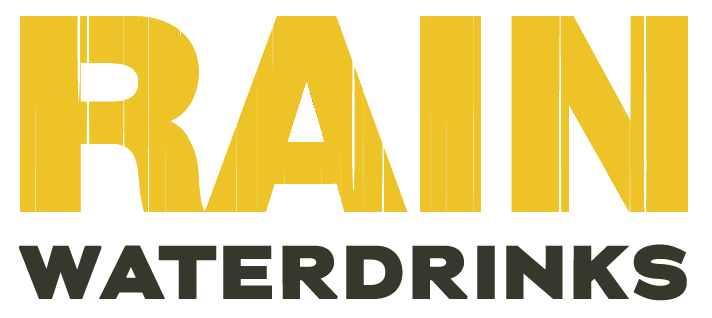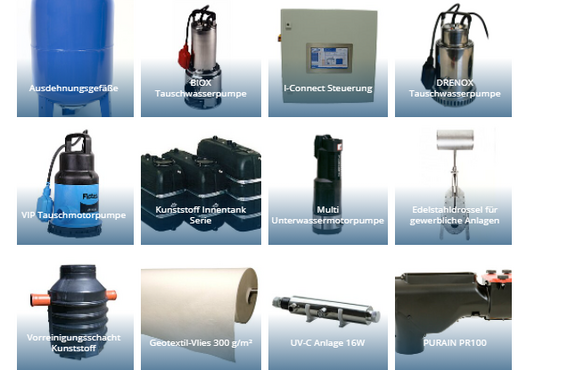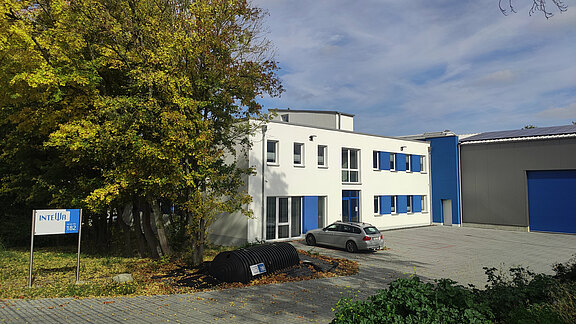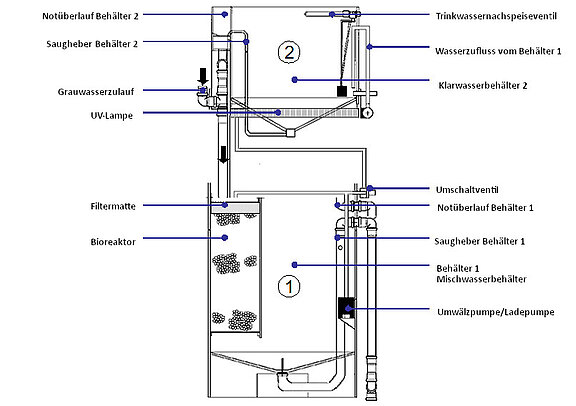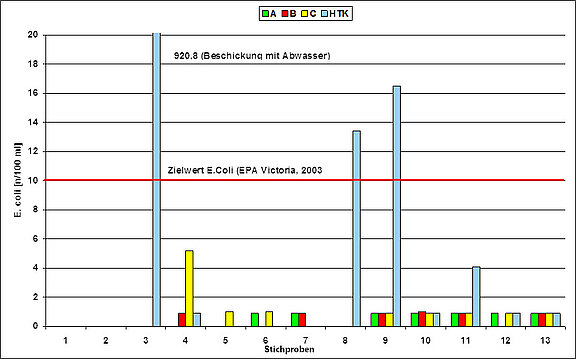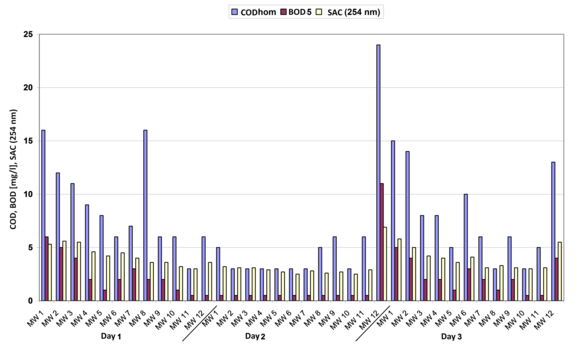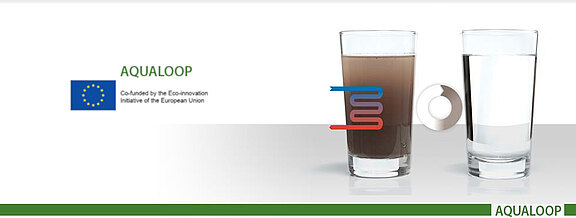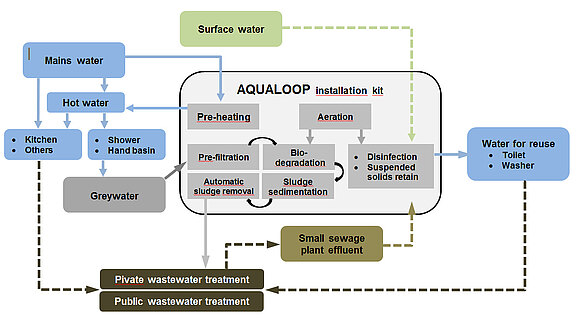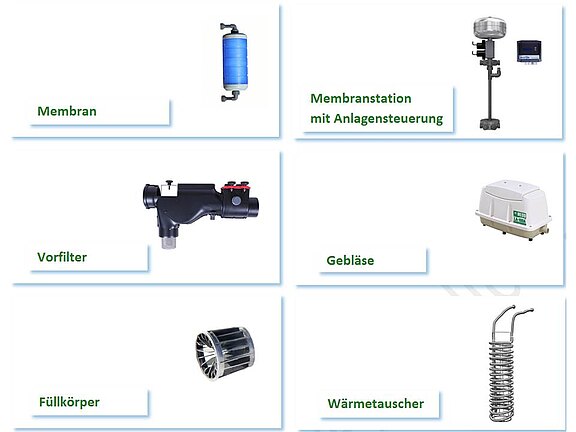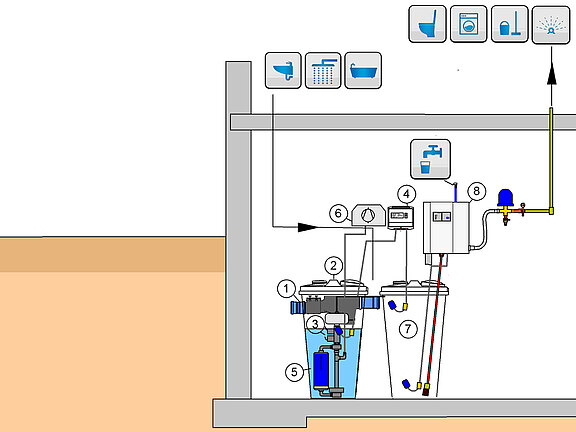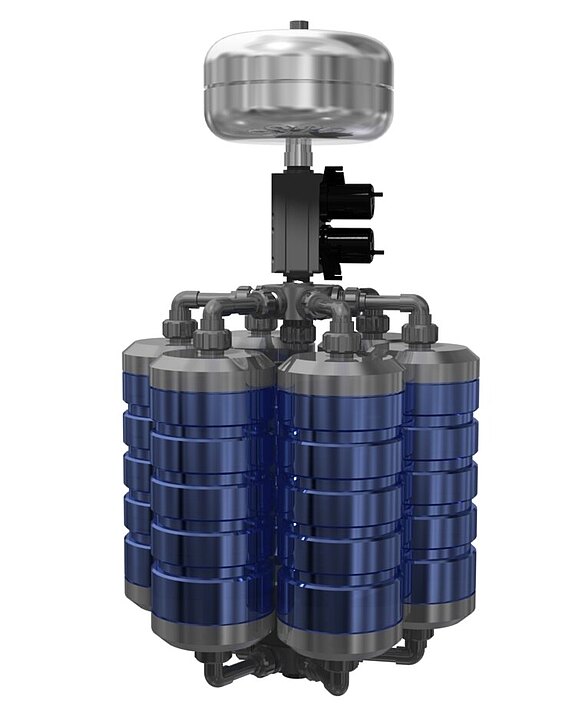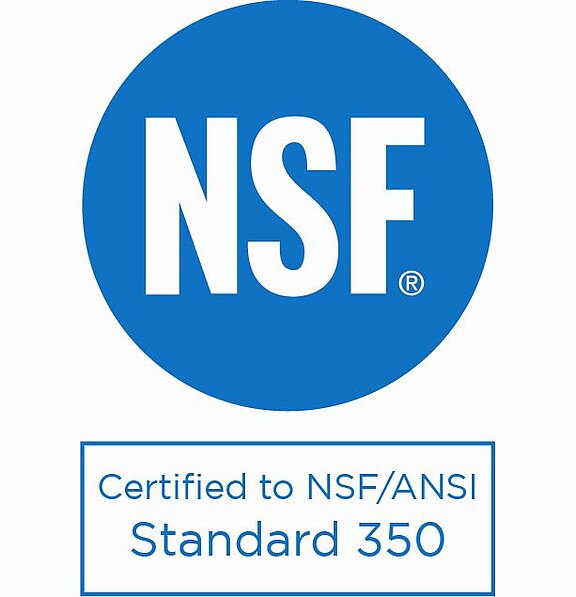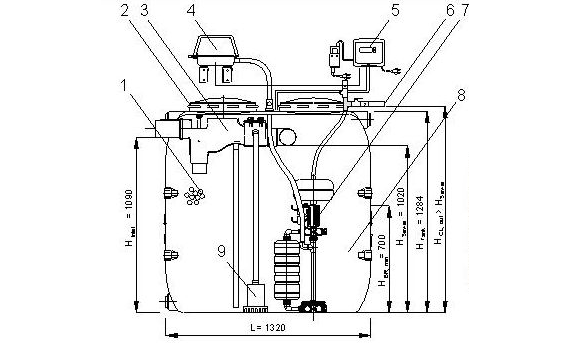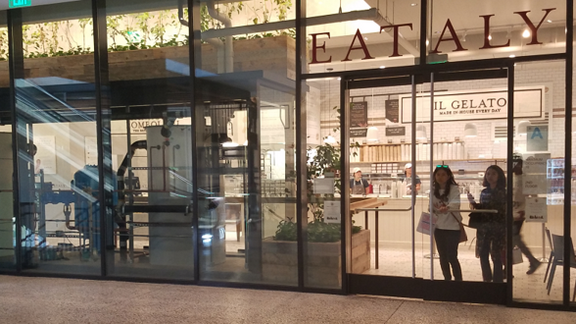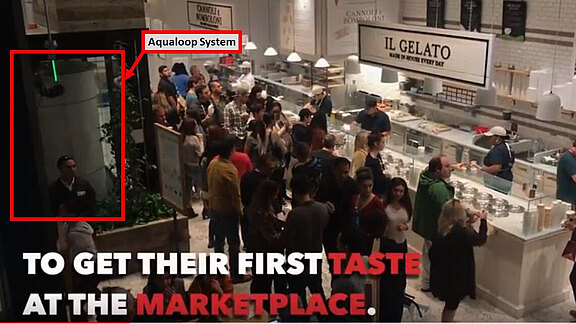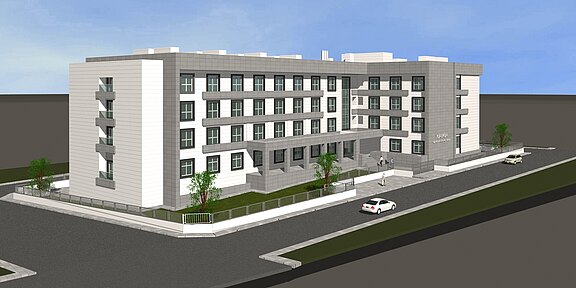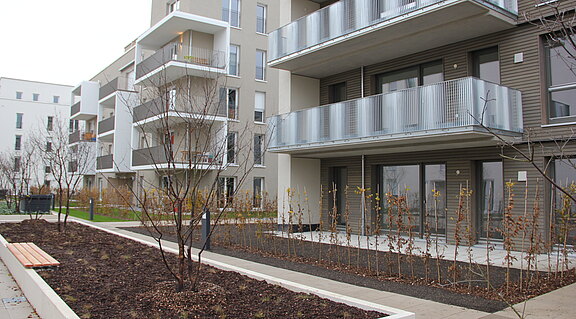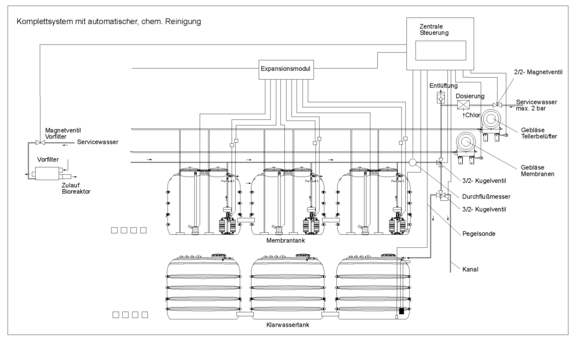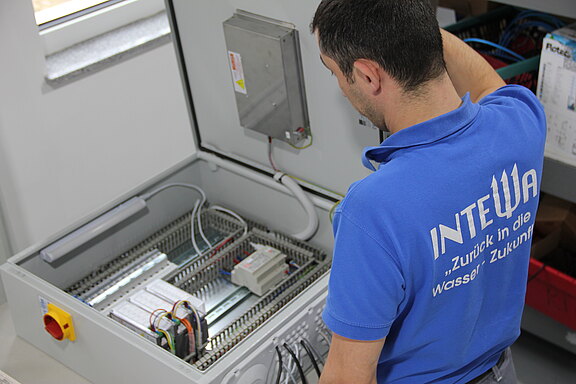Greywater recycling: Out of the niche
Up to 65% of a person's total water requirement is for personal hygiene such as showering, bathing, hand washing and for the washing machine which make up what is called greywater. This water is lightly polluted and, after appropriate treatment, can be ideally reused for toilet flushing, laundry washing, and garden irrigation.
Future technology greywater recycling: new technology enables water saving and return on investment in equal measure
Up to 65% of a person's total water requirement is for personal hygiene such as showering, bathing, hand washing and for the washing machine which make up what is called greywater. This water is lightly polluted and, after appropriate treatment, can be ideally reused for toilet flushing, laundry washing, and garden irrigation.
To date, the subject of greywater recycling for process water supply has only really been familiar to a few experts. Only in rare exceptional cases are such systems used in new construction in Germany. Even on a global scale, grey water and its heat energy usually discharged unused to the sewer. Numerous manufacturers of grey water systems who have brought systems onto the market in recent years have disappeared again due to technical complexity and poor operating results. Why is this so? The causes are complex. First, there has simply been a lack of the right design concept to date. Many grey water systems were based on simple settling and coarse filtration, followed by chlorination. Others were based on pure biological treatment with no filtration. Still others employed membrane bioreactors, but with a complex design that requires a full-time operator. In the end, almost all these systems failed because the required water quality could not be guaranteed consistently, the systems were too expensive to install, or too maintenance-intensive. In particular, when recycled water is used in buildings, the occasional poorer quality is absolutely unacceptable to the user.
For a few years now, however, new technologies have made systems possible that pay for themselves within a short time at water costs of 5.00 Euros/m³ and deliver very good water quality. In this technical article the topic greywater recycling is brought to focus in a new way. Over the last 10 years, Intewa has conducted research projects and has gained experience with hundreds of installations worldwide to bring its Aqualoop technology to state of the art with several technical advances and great prospects for future developments.
Results from the 1st research project "Research, development and construction of a new greywater recycling system"
(AIF funded research project 1.12.2007 to 31.12.2008)
Overview
Within the scope of the AIF-funded project, a prototype greywater treatment system of INTEWA GmbH was to be investigated and evaluated. For this purpose, three greywater systems installed in private households were sampled and subjected to stress tests. In addition, a larger plant was installed at the experimental sewage treatment plant of "Landesamt für Natur und Umwelt NRW "(LANUV) (HTK-Neuss) operated by the Institute for Urban Water Management of the RWTH Aachen University. Special attention was paid to the disinfection of the purified greywater in all plants.
Operating principle
The greywater treatment plants developed for this research project worked in batch mode using a biological in which biofilm was allowed to develop to consume contaminants. In each system, raw greywater flows through a filter mat and the bioreactor filled with fixed bed material, the mixed water tank 1 (Fig. 2). Here it passes through the bioreactor with the aid of a circulation pump with a flow of 5 l/min inside vessel 1 (volume: 400 l) for five hours. This pump then conveys the purified grey water through a UV lamp for one hour into the clear water tank (tank 2, volume: 100 l). When the clear water tank is completely full, the excess water flows back into tank 1. The clear water is used for toilet flushing. If the quantity of purified grey water is not sufficient for flushing the connected toilet, drinking water is automatically added to the clear water tank to assure uninterrupted service. Any excess raw greywater in Tank 1 overflows to sewer.
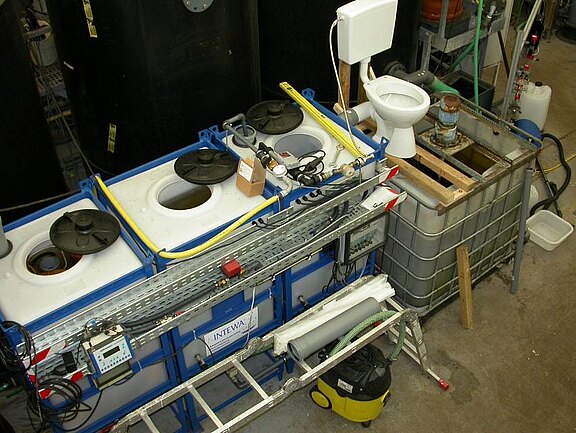

Operational Results
Very low mean BOD values of 2.2 mg/l were easily achieved. Continuous circulation of the entire water supply led, as planned, to continuous minimization of BOD to a level at which treated water can be stored for extended periods. As with a river, the water is constantly in motion. Due to recirculation, auxiliary aeration was unnecessary. Cleaning is carried out exclusively by mixing, settling, biological degradation, and UV sterilization. No chemical or biological additives were required.
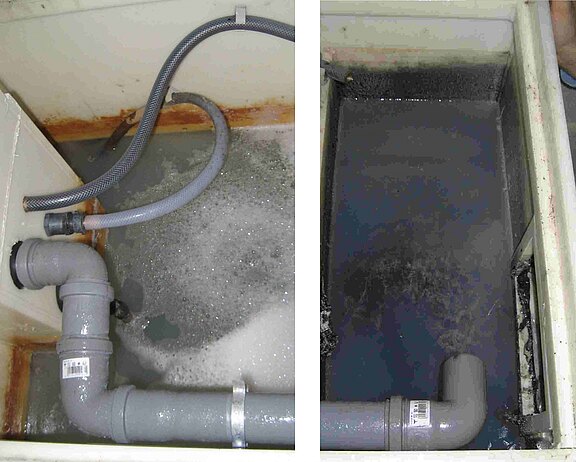
At plant B there were several technical faults, caused both by plant components (pump failure, replenishment failure) and by water purification. Since no pre-filtering was installed, the system was exposed to higher loads than planned. As a result of the added fixed bed, the system overflowed when the bath water was drained. It should be mentioned that the consumer behavior was also unfavorable for the operation of this plant, as an inflow only took place once or twice a week when almost the entire family was bathing.
Due to insufficiently uniform distribution of the circulating water over the fixed bed, anaerobic areas appeared in two plants. By better pre-filtering and optimization of the fixed bed, both plants ran well at the end of the project.
System B: Cleaning of the system which has become clogged after a short period of operation.
Microbiology
The results of the microbiological examinations of the samples provided good results for the private house installations of less than 10 E.coli / 100 ml. These are illustrated here using the E.coli as an example:
At the HTK plant, the increased occurrence of microorganisms was due to the location in a hall where experiments were carried out with wastewater. Since the covers of the plant were mainly open to determine additional parameters such as oxygen content and pH value, to observe the water distribution on the fixed bed or to be able to intervene more quickly in the event of malfunctions, pathogens were introduced by air.
Biological Degradation Performance
The elimination performance of the microorganisms established on the fixed bed material is of decisive importance for the effectiveness of the grey water treatment plants. During the entire duration of the project, random and mixed samples were taken in the plants several times over a period of 5 to 72 hours.
The following diagram shows the results of the analysis of samples from the mixed water tank of plant A over a period of 3 days. Sampling began at 8 a.m. each morning. The BOD5 target value of 5 mg/l is only briefly exceeded at the beginning of the respective showering processes. Since the mixed water is only pumped into the clear water tank after 5 hours of treatment, the limit value in the clear water tank is always adhered to.
The following table lists the data of the statistical evaluation of the sampling:
COD | BOD5 | SAC 254 nm | |
| [mg/l] | [mg/l] | [mg/l] | |
| Average value | 7,9 | 2,2 | 3,8 |
| Median | 6,0 | 1,0 | 3,7 |
| Standard deviation | 5,4 | 2,4 | 1,1 |
| 95-percentile | 17,2 | 6,6 | 5,7 |
| Maximum | 24 | 11 | 6,9 |
| Minimum | 3 | 0,5 | 1,9 |
The minima of COD and BOD are below the determination limits
Conclusion
The greywater treatment plant developed by the company INTEWA has proven to be an effective device for reducing water consumption in private households in scientifically supervised practical operation. The shower water is biologically purified and disinfected by means of a UV lamp in such a way that this type of grey water treatment plant could have been used without any problems for the supply of service water quality, e.g. for flushing toilets. The tests showed that the chemical and microbiological target values of, for example, less than 10 E.coli / 100 ml and a BOD of < 5 mg/l in the process water (clear water storage tank) can be maintained. From the experiments with real shower water and various plant sizes, the project was able to derive design values for the elimination behavior and the resulting plant dimensions.
After the end of the research project, the prototype plants were operated for several years in order to gain long-term experience. It turned out that the fixed bed blocked too quickly during long-term operation. This led to an unplanned, increased maintenance requirement of less than one year. Although the research project delivered promising results overall, it was finally decided not to bring this technology onto the market. In addition to increased maintenance, the main reason for this was that if the biological stage failed, no 100% guarantee could be given that the water quality would be maintained. This learning led us to a new research project with a new ultrafiltration technology (Aqualoop) to achieve an effective pollution barrier before reusing the water in the household. The results of the first research project, in particular on the degradation behaviour of the biofilm process, could continue to be used.
AQUALOOP - the installation kit for water treatment and heat recovery. ECO-Innovation, First Application and market replication projects, 2013 to 2015
Task
This EU-funded project had the initial objective of developing a technology capable of recycling greywater and providing high water quality at a reasonable cost level (well below water prices). Contrary to other research projects, the CIP Eco-Innovation Call focused on implementation and demonstration. The aim was to use AQUALOOP to develop complete water reuse systems including heat recovery for the production of clean, high-quality treated water and to prepare for market entry. This should be independent of whether the input greywater from houses, wastewater from sewage treatment plants, or surface water. The innovative water and heat recovery technology should reduce water demand by more than 50% and water heating energy by 15% in a wide range of applications such as private homes, hotels, campsites, commercial and public buildings, industrial facilities, etc. In this technical report, the focus is placed on the application of "greywater recycling".
Operating Principle
With the AQUALOOP kit as basic components and local standard components such as tanks, piping and water supply units, companies worldwide should be able to create complete water reuse systems with heat recovery for different applications.
In addition to the quality and price optimization of the components, the project also included the optimization of the process, including membrane technology. The aim was to reduce energy consumption and increase both manual/chemical cleaning intervals as well as the service life of the membranes and components.
The technology was to be investigated, evaluated and introduced to the market on the basis of various demonstration plants, from single-family houses to industrial plants. In the following, two of the research plants for grey water recycling are described as examples:
Operation results
Greywater recycling for a detached house in Kelmis, Belgium
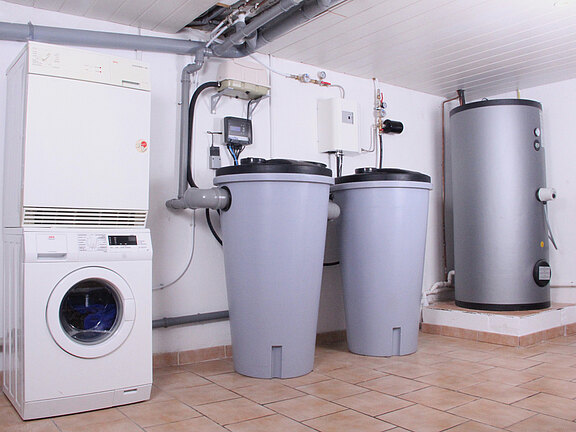
The system designed for up to 6 persons, which is shown in the following picture, consists of a bioreactor and a clear water tank. Each tank has a total volume of 350 litres. The prefilter and the growth bodies are located in the bioreactor. Solid materials (e.g. hair, sand) are extracted by filtration, while organic components are removed by biological treatment. Bacterial activity is made possible by aeration of the greywater. Soil, sediment, and suspended matter from the storage tank are automatically discharged in overflow times.
The membrane station is installed in the bioreactor. This contains the platform for the installation of the membrane cartridges. A permeate pump, a backwash pump, and a backwash tank are also integrated. The membrane station also includes a fully automatic control system for operation and monitoring of the pumps and aerator. The ultrafiltration membrane cartridges are special hydrophilic PE hollow fibres with a pore size of 0.02 μm, which exclude bacteria to 6 log and virus to 2.7. The aerator supplies the bioreactor with oxygen and cleans the membranes simultaneously via air scour.
The fully automatic pump and monitoring station (RAINMASTER), certified by the DVWG, contains pump, control and automatic mains back up. The treated water is pumped from the clear water tank via a suction hose and used for toilet flushing, washing machine, and spray irrigation. If the quantity of treated grey water is too small, the DVGW-certified RAINMASTER automatically switches to mains water.
| 1. Prefilter | 5. Membranes (1-6 per AL-MS) |
| 2. Bioreactor incl. growth bodies | 6. Blower |
| 3. Membrane station | 7. Clearwater tank |
| 4. Controller | 8. RAINMASTER |
The plant, which was installed in November 2013, is still in operation today after 6 years, almost in its original version. The pre-filter has now been equipped with automatic backwashing and is now maintenance-free every six months except for hair removal. The ultrafiltration membrane proved to be a safe barrier against germs. A great deal of time was invested in optimizing the membrane operation. The aim of the concept was an almost maintenance-free plant operation (maintenance intervals of 1-2 years) without the use of chemical cleaning agents. Due to the enormous membrane area of 6 m² per cartridge, a corresponding stabilization flux could also be achieved at which the water throughput is stable with no cleaning required. The stabilization flux of 0.5 l/min on the other hand results in permeate pump running times of over 7 hours per day to transfer 200 litres. Accordingly, a pump assembly was developed on the system side which runs reliably for over 20,000 operating hours and has a very low power consumption due to speed control and 24 V power. The maximum power consumption of the system is 80 watts. The total energy requirement for treatment and pumping of one cubic meter of water was calculated to be 2.2 kWh.
Due to the small plant size and the small temperature difference in the bioreactor by mixing the warm shower water with the already cooled water in the bioreactor, the original heat exchanger concept was rejected. Instead, the system was converted to a plate heat exchanger outside the storage tank to take advantage of the higher discharge water temperatures. In the end, all heat exchanger concepts investigated proved to be technically and economically inefficient for the relatively small systems and in particular in consideration of the relevant standards for media separation (separate heat exchanger circuit). It should be mentioned that heat recovery from the bioreactor is counterproductive to the efficiency of the biological degradation behavior in the fluidized bed resulting in suboptimal temperature for biological growth.
Standards, Safety and Certification
Since October 2017, the current draft European standard DIN EN 16941-2 "Systems for the use of treated grey water" has laid down the basic principles of design, sizing, installation, marking, commissioning, and maintenance of grey water recycling systems as well as the minimum water quality requirements for the use of grey water on site. This document was prepared by the Technical Committee CEN/TC 165 "Wastewater Engineering", whose secretariat is held by DIN (Germany). The responsible German body is NA 119-05-08 AA "Water recycling - Development of standards for the use of rainwater and grey water" in the DIN Standards Committee for Water Management (NAW).
Before that time, only the British Standard BS 8525-1:2010 "Greywater systems" existed in Europe. Outside Europe, there are various Australian standards and the American NSF/ANSI 350. This test standard, the only one of its kind in the world, is the basis for a certification process for various quality levels. For the research project it was quickly clear that the INTEWA grey water recycling system should be tested according to the NSF/ANSI 350 standard and, if possible, certified. The following graphic shows the test system used for the 26-week test according to the NSF/ANSI 350 standard:
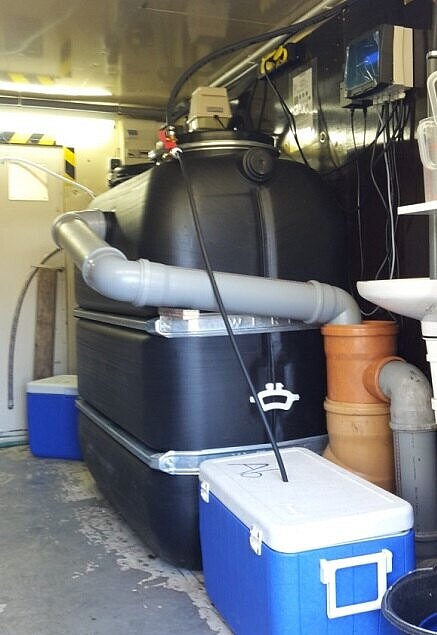
The test system described below was set up and tested at the PIA testing institute in Aachen in a specially designed test container. The NSF test included the particular challenge that no maintenance could be carried out on the system during the 26-week test period. In addition, there were special stress tests such as holiday periods, increased dirt input (impact load), power failure and other practical tests. The greywater composition or challenge water has been defined for a uniform test standard. In particular, the fine test dust used posed a particular challenge for the ultrafiltration membrane. However, the cartridge designed by INTEWA with integrated ventilation and bundled PE hollow fibre membranes cleaned sufficiently so that the required flux level was met to assure no membrane cleaning would be required in the 6 month test period.
The following table describes the NSF inlet and discharge water qualities achieved by INTEWA:
|
1 NA: not applicable.
² Calculated as geometric mean.
³ MR: measured and reported only.
4 System for treating bathing and laundry source waters (combined)
The INTEWA test system fulfilled all requirements and was the first and so far only system to be certified according to "Class C". In contrast to Class R (turbidity 5 NTU, E.coli 14 MPN/100 ml as average values), Class C, for example, allows an average of maximum of 2 NTU and 2.2 E.coli to be achieved. Class C systems are intended in particular for commercial grey water systems. Overall, the entire INTEWA system series AL-GW600 to AL-GW5400 was certified according to NSF/ANSI 350-2014 with a range up to 5400 litres per day (1427 gallons per day). Larger capacities are also NSF compliant if they are designed in accordance with the treatment volume and duration specified in the INTEWA NSF report and certification.
Conclusion
Within the framework of this EU research project, a technology could be developed and demonstrated guaranteeing high-quality service water from greywater at any time by means of biological treatment ultrafiltration in a membrane bioreactor (MBR). The plants are also characterised by infrequent maintenance and a service life of the membrane technology of ten years. Continuous chemical cleaning could be eliminated. However, the long maintenance intervals result in a relatively low flow rates through the membrane (stabilising flux) with a large membrane surface and thus long permeate pump running times. At water prices of 5.00 Euro/m³ (drinking water plus wastewater), these systems can pay for themselves within a period of well under ten years, depending on the size of the system, and were therefore already of interest for commercial building services.
Greywater Systems in Operation
In the years following the research projects, over 100 INTEWA greywater systems have been installed worldwide. A short description of some interesting systems can be found in the following chapter:
Eataly in Los Angeles with a view to Hollywood 2017
The 67,000 square meter Eataly complex in Los Angeles comprises a whole range of Italian restaurants and food markets. This world-famous gastronomic oasis has locations in New York, Boston and Chicago, but its greenest facility has now officially opened in Los Angeles in 2017. The very first commercial NSF-350 Class C-certified grey water system was considered a a focal point with the Aqualoop system prominently displayed right next to the gelato bar in a glass enclosure. The fully automatic system collects approximately 2000 litres of water from the hand basins and air conditioner condensate, processes it, and reuses it for flushing the toilets and watering plants. Two AQUALOOP GW1800L membrane stations are used.
Turkey Bayindir University , Student Residence 2016
The Bayindir University's search for a greywater recycling system was based on the high treatment quality and the small space requirement. More than 100 students of this university now use grey water and save 8 m³ of drinking water every day. The grey water is treated for toilet flushing and irrigation. The system consists of two AQUALOOP GW1800L membrane stations and a PURAIN Filter PR 150.
Community Living, Munich 2017
Greywater from showers, bathtubs, and bathroom sinks is pre-filtered by a PR150-S PURAIN Filter, before being sent to the 5,000 L plastic tank (bioreactor). This is where the biological treatment takes place. The skimmer overflow on the PURAIN filter removes any floating particles. With two AQUALOOP GW1800L membrane stations in the bioreactor, the greywater will be ultra-filtered and supplied to a treated water storage tank (5,000 L). The greywater treatment for this project is achieved as an indoor tank system. Through a supply pump in the treated water storage, the treated clear water is pumped to a holding tank in a PROFI pump and control centre. From there the duplex pump system supplies the toilets and external taps for watering.
Economic Efficiency
In the course of development, the so-called payback time for systems with approximately 5 m³ / day has dropped from more than 20 years to now less than 7 years. Considering the water price, the user of such a system can calculate with a water price of approximately 2,00€/m³. This includes incoming drinking water and wastewater discharge costs. Since in Germany the price averages 5,00€/m³, one sees fast that Aqualoop greywater recycling systems can achieve quick payback times.
Greywater 4.0: Central Control, Remote Monitoring, and Cloud
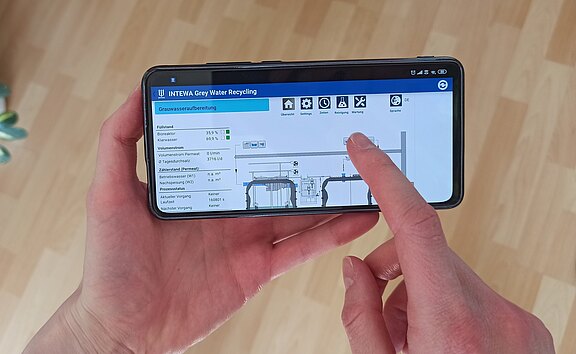
In recent years the demand and requirements for larger grey water systems have grown. To date, INTEWA has offered modular control systems that are redundant and completely self-sufficient. Higher water requirements meant using further AQUALOOP membrane stations with a separate control system. A completely new, central control concept has now been developed especially for systems from 5400 l/day (or greater if multiple parallel systems are used), which combines numerous advantages. The standard series for plants up to 100 m³/day will be on the market within a few months and includes a central, digitalized control system with fully automatic chemical cleaning. The systems only need to be connected to the Internet with a LAN cable and thus configured and maintained worldwide.
The new control technology
The new control technology offers numerous advantages for designers, operators, and maintenance personnel:
1. Systems are scalable and expandable by modularity of the control units and treatment
2. Security
a. DSGVO-compliant data processing
b. HTTPS, encryption of data transmission
c. CE, UL, compliant hardware
3. Hardware interfaces
a. 100 Mbit Ethernet
b. Internet connection without router Port Activation
c. BUS interface (Bacnet, Modbus, LONWorks, and more)
4. Web application with visualization or autonomous
5. Cloud-based web interface for operation and visualization, billing, license models, long-term evaluation and prediction
The greywater system of the future can thus be controlled from anywhere. Reading water throughput, statistics, electricity consumption, optimizing system parameters and recommendations for maintenance are just a few of the tangible benefits that this technology should bring. For large buildings, integration into the local building management system (BMS) is possible via the already integrated interfaces. This significantly optimizes operating and maintenance costs and contributes to further optimization of the economic efficiency of the systems.
Summary and Outlook
This article described the development process that took more than ten years, from the first grey water prototype systems to today's modern systems with certification, automated maintenance, cloud application and economical operation. I would particularly like to thank our employees, partners, customers, suppliers, and sponsors. Without their help, the current state of the technology would not have been possible. It is possible that in the future greywater recycling will become ubiquitous in commercial buildings, because grey water recycling is now both ecologically valuable and economically viable. This achieves water qualities that meet the highest NSF/ANSI 350 Class C standards. Development and next generation design for Aqualoop are ongoing. In the future, Aqualoop systems will be even more economical and the water quality even better. INTEWA and other research departments are already working on a combination of different water sources and even new treatment processes. The goal: a self-sufficient, decentralized, and sustainable water supply. To be continued ...
Dipl. Ing. Oliver Ringelstein
INTEWA GmbH
Auf der Hüls 182
52068 Aachen
Tel: 0241-96605-0
Mobil: 0163-6966050
Autor: Oliver Ringelstein, INTEWA GmbH
Further Information:
Basiswissen Wasseraufbereitung
Information to EU Projekt
Certifications
Note: Modifications of the technical article are permitted only with express permission of the writer!


